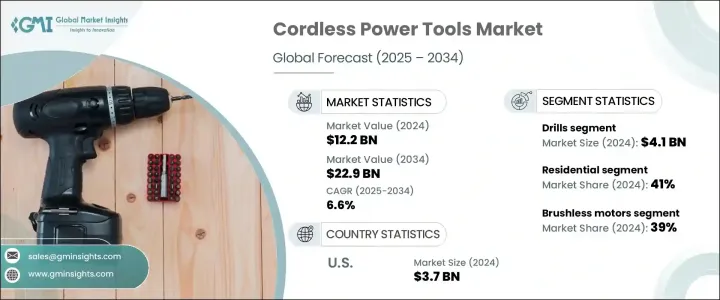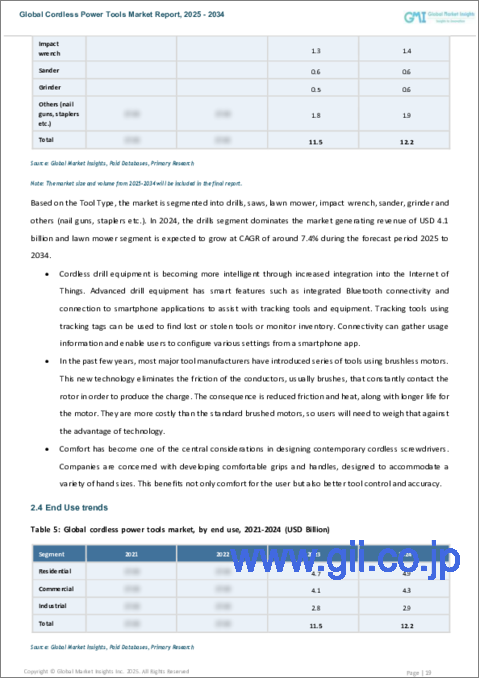|
|
市場調査レポート
商品コード
1716635
コードレス電動工具市場の機会、成長促進要因、産業動向分析、2025年~2034年の予測Cordless Power Tools Market Opportunity, Growth Drivers, Industry Trend Analysis, and Forecast 2025 - 2034 |
||||||
カスタマイズ可能
|
|||||||
| コードレス電動工具市場の機会、成長促進要因、産業動向分析、2025年~2034年の予測 |
|
出版日: 2025年03月05日
発行: Global Market Insights Inc.
ページ情報: 英文 220 Pages
納期: 2~3営業日
|
全表示
- 概要
- 目次
世界のコードレス電動工具市場は、2024年に122億米ドルと評価され、2025年から2034年にかけてCAGR 6.6%で拡大すると予測されています。
この成長の原動力となっているのは、バッテリー技術の急速な進歩、DIYホームプロジェクトへの関心の高まり、世界の建設・産業活動の活発化です。携帯性に優れ、使いやすく、効率的な工具に対する需要の高まりは、電動工具業界を一変させ、コードレス電動工具をプロ用および個人用の工具セットの不可欠な一部にしています。コード付きからコードレスへの移行が進んでいるのは、最新のコードレス工具が提供する利便性、柔軟性、性能によるところが大きく、ユーザーはコンセントやコードの絡まりを気にすることなく、より効率的に作業できます。

世界的に都市化と工業化が加速しており、特に新興経済諸国では建設とインフラ開拓が急増しており、市場の成長をさらに後押ししています。さらに、先進的な機能を備えたスマートツールやコネクテッドツールの人気が高まっていることも、住宅ユーザーとプロフェッショナルユーザーの両方にとって魅力的です。環境の持続可能性に関する懸念の高まりとエネルギー効率の高いソリューションの必要性も、コードレス工具の生産に環境に優しい材料と技術を採用するようメーカーを促しています。
| 市場範囲 | |
|---|---|
| 開始年 | 2024 |
| 予測年 | 2025-2034 |
| 開始金額 | 122億米ドル |
| 予測金額 | 229億米ドル |
| CAGR | 6.6% |
リチウムイオン・バッテリーは、ほとんどのコードレス工具の主要な電源として台頭し、従来の代替品と比較して、より長い動作時間、より速い充電、優れた効率を可能にしています。これらのバッテリーは自己放電率が低いことで知られ、非アクティブ時に充電を長く保持できます。ニッケル・カドミウムやその他の古いタイプのバッテリーとは異なり、リチウムイオン・バッテリーには有害なカドミウムが含まれていないため、より安全で環境に配慮した選択肢となっています。先進的なリチウムイオンバッテリー技術の統合は、コードレスツールの性能、耐久性、持続可能性を大幅に向上させ、建築のプロから気軽なDIY愛好家まで幅広いユーザー層を引き付けています。
コードレス電動工具には、ドリル、のこぎり、芝刈り機、インパクトレンチ、サンダー、グラインダーなど、幅広い機器が含まれます。その中でもドリル分野は、商業用と住宅用両方のユーザーからの強い需要に支えられ、2024年には41億米ドルを生み出しました。技術革新の進化に伴い、コードレスドリルはBluetooth接続とアプリベースの制御を内蔵してよりスマートになっており、ユーザーは工具の使用状況を追跡し、性能を監視し、紛失した工具を見つけることさえできます。このレベルのインテリジェンスと統合は、ユーザーの工具との付き合い方を再形成し、利便性と効率性の向上をもたらしています。
市場はエンドユーザー別に、住宅、商業、工業のカテゴリーに区分され、2024年のシェアは、ホームセンターやDIYの動向の高まりを背景に、住宅が41%を占める。住宅や商業施設の建設プロジェクトが増え続けるにつれ、多機能で高性能なコードレス工具のニーズも高まっています。米国のコードレス電動工具市場は2024年に37億米ドルを生み出し、高度な工具技術、住宅改修への消費支出の増加、DIY活動の急増に支えられています。強化されたバッテリー寿命、急速充電、人間工学に基づいた設計により、コードレス工具はあらゆる業界のユーザーに好まれる選択肢となっています。
目次
第1章 調査手法と調査範囲
第2章 エグゼクティブサマリー
第3章 業界洞察
- エコシステム分析
- バリューチェーンに影響を与える要因
- 利益率分析
- ディスラプション
- 将来の展望
- 製造業者
- 流通業者
- サプライヤーの情勢
- 技術的展望
- 主要ニュース&イニシアティブ
- 規制状況
- 影響要因
- 促進要因
- バッテリー技術の進歩
- DIYやホームセンターでの需要の増加
- 業界の潜在的リスク&課題
- 高いイニシャルコスト
- 原材料価格の変動
- 促進要因
- 成長可能性分析
- ポーター分析
- PESTEL分析
第4章 競合情勢
- イントロダクション
- 企業シェア分析
- 競合のポジショニング・マトリックス
- 戦略展望マトリックス
第5章 市場推計・予測:ツールタイプ別、2021年~2034年
- 主要動向
- ドリル
- のこぎり
- 芝刈り機
- インパクトレンチ
- サンダー
- グラインダー
- その他(ネイルガン、ステープラーなど)
第6章 市場推計・予測:モータータイプ別、2021年~2034年
- 主要動向
- ブラシ付きモーター
- ブラシレスモーター
第7章 市場推定・予測:電圧別、2021年~2034年
- 主要動向
- 12V
- 18V
- 20V
- 40V
- 40V以上
第8章 市場推計・予測:最終用途別、2021年~2034年
- 主要動向
- 住宅
- 商業
- 産業
第9章 市場推計・予測:用途別、2021年~2034年
- 主要動向
- 建設
- 自動車
- 航空宇宙
- エネルギー
- エレクトロニクス
- DIY
- その他(製造業など)
第10章 市場推計・予測:流通チャネル別、2021年~2034年
- 主要動向
- 直接販売
- 間接販売
第11章 市場推計・予測:地域別、2021年~2034年
- 主要動向
- 北米
- 米国
- カナダ
- 欧州
- 英国
- ドイツ
- フランス
- イタリア
- スペイン
- ロシア
- アジア太平洋
- 中国
- インド
- 日本
- 韓国
- オーストラリア
- ラテンアメリカ
- ブラジル
- メキシコ
- 中東・アフリカ
- UAE
- サウジアラビア
- 南アフリカ
第12章 企業プロファイル
- Apex Tool
- Dynabrade Power Tools
- Festool
- Hilti
- Hitachi Koki
- KEN Holding
- Makita
- Robert Bosch
- Ryobi
- Snap-on Tools Company
- Stanley Black &Decker
- Stihl
- Techtronic
- TTI Group
- Yamabiko
The Global Cordless Power Tools Market was valued at USD 12.2 billion in 2024 and is projected to expand at a CAGR of 6.6% from 2025 to 2034. The growth is fueled by rapid advancements in battery technologies, growing interest in DIY home projects, and rising construction and industrial activities worldwide. The growing demand for portable, easy-to-use, and efficient tools has transformed the power tools industry, making cordless power tools an essential part of both professional and personal toolkits. The increasing shift from corded to cordless variants is largely driven by the convenience, flexibility, and performance offered by modern cordless tools, allowing users to work more efficiently without worrying about power outlets or tangled cords.

With urbanization and industrialization accelerating globally, especially in emerging economies, construction, and infrastructure development are surging, further supporting market growth. In addition, the rising popularity of smart and connected tools with advanced features is appealing to both residential and professional users, as consumers are increasingly seeking tools that offer higher productivity, better ergonomics, and added safety features. Growing concerns around environmental sustainability and the need for energy-efficient solutions are also prompting manufacturers to adopt eco-friendly materials and technologies in cordless tool production.
| Market Scope | |
|---|---|
| Start Year | 2024 |
| Forecast Year | 2025-2034 |
| Start Value | $12.2 Billion |
| Forecast Value | $22.9 Billion |
| CAGR | 6.6% |
Lithium-ion batteries have emerged as the dominant power source for most cordless tools, enabling longer operating times, faster charging, and superior efficiency compared to traditional alternatives. These batteries are known for their low self-discharge rates, allowing them to hold a charge longer during inactivity. Unlike nickel-cadmium or other older battery types, lithium-ion batteries do not contain harmful cadmium, making them a safer and more environmentally responsible option. The integration of advanced lithium-ion battery technologies is driving significant improvements in the performance, durability, and sustainability of cordless tools, thus attracting a broader user base ranging from professionals in construction to casual DIY enthusiasts.
Cordless power tools encompass a wide range of equipment, including drills, saws, lawnmowers, impact wrenches, sanders, grinders, and more. Among these, the drills segment generated USD 4.1 billion in 2024, backed by strong demand from both commercial and residential users. As innovation evolves, cordless drills are getting smarter with built-in Bluetooth connectivity and app-based controls, allowing users to track tool usage, monitor performance, and even locate lost tools. This level of intelligence and integration is reshaping how users interact with their tools, delivering enhanced convenience and efficiency.
The market is segmented by end users into residential, commercial, and industrial categories, with the residential segment accounting for a 41% share in 2024, driven by rising home improvement and DIY trends. As residential and commercial construction projects continue to grow, so does the need for multi-functional and high-performing cordless tools. The U.S. Cordless Power Tools Market generated USD 3.7 billion in 2024, supported by advanced tool technologies, growing consumer spending on home upgrades, and surging DIY activities. Enhanced battery life, rapid charging, and ergonomic designs are making cordless tools a preferred choice for users across industries.
Table of Contents
Chapter 1 Methodology & Scope
- 1.1 Market scope & definitions
- 1.2 Base estimates & calculations
- 1.3 Forecast calculations
- 1.4 Data sources
- 1.4.1 Primary
- 1.4.2 Secondary
- 1.4.2.1 Paid sources
- 1.4.2.2 Public sources
Chapter 2 Executive Summary
- 2.1 Industry synopsis, 2021-2034
Chapter 3 Industry Insights
- 3.1 Industry ecosystem analysis
- 3.1.1 Factor affecting the value chain
- 3.1.2 Profit margin analysis
- 3.1.3 Disruptions
- 3.1.4 Future outlook
- 3.1.5 Manufactures
- 3.1.6 Distributors
- 3.2 Supplier landscape
- 3.3 Technological landscape
- 3.4 Key news & initiatives
- 3.5 Regulatory landscape
- 3.6 Impact forces
- 3.6.1 Growth drivers
- 3.6.1.1 Advancement in battery technological
- 3.6.1.2 Increased demand in DIY and home improvement
- 3.6.2 Industry pitfalls & challenges
- 3.6.2.1 High initial costs
- 3.6.2.2 Fluctuations in raw material prices
- 3.6.1 Growth drivers
- 3.7 Growth potential analysis
- 3.8 Porter's analysis
- 3.9 PESTEL analysis
Chapter 4 Competitive Landscape, 2024
- 4.1 Introduction
- 4.2 Company market share analysis
- 4.3 Competitive positioning matrix
- 4.4 Strategic outlook matrix
Chapter 5 Market Estimates & Forecast, By Tool Type, 2021-2034 (USD Billion) (Thousand Units)
- 5.1 Key trends
- 5.2 Drills
- 5.3 Saws
- 5.4 Lawn mower
- 5.5 Impact wrench
- 5.6 Sander
- 5.7 Grinder
- 5.8 Others (nail guns, staplers etc.)
Chapter 6 Market Estimates & Forecast, By Motor Type, 2021-2034 (USD Billion) (Thousand Units)
- 6.1 Key trends
- 6.2 Brushed motor
- 6.3 Brushless motor
Chapter 7 Market Estimates & Forecast, By Voltage, 2021-2034 (USD Billion) (Thousand Units)
- 7.1 Key trends
- 7.2 12V
- 7.3 18V
- 7.4 20V
- 7.5 40V
- 7.6 Above 40V
Chapter 8 Market Estimates & Forecast, By End Use, 2021-2034 (USD Billion) (Thousand Units)
- 8.1 Key trends
- 8.2 Residential
- 8.3 Commercial
- 8.4 Industrial
Chapter 9 Market Estimates & Forecast, By Application, 2021-2034 (USD Billion) (Thousand Units)
- 9.1 Key trends
- 9.2 Construction
- 9.3 Automotive
- 9.4 Aerospace
- 9.5 Energy
- 9.6 Electronics
- 9.7 DIY
- 9.8 Others (manufacturing etc.)
Chapter 10 Market Estimates & Forecast, By Distribution Channel, 2021-2034 (USD Billion) (Thousand Units)
- 10.1 Key trends
- 10.2 Direct sales
- 10.3 Indirect sales
Chapter 11 Market Estimates & Forecast, By Region, 2021-2034 (USD Billion) (Thousand Units)
- 11.1 Key trends
- 11.2 North America
- 11.2.1 U.S.
- 11.2.2 Canada
- 11.3 Europe
- 11.3.1 UK
- 11.3.2 Germany
- 11.3.3 France
- 11.3.4 Italy
- 11.3.5 Spain
- 11.3.6 Russia
- 11.4 Asia Pacific
- 11.4.1 China
- 11.4.2 India
- 11.4.3 Japan
- 11.4.4 South Korea
- 11.4.5 Australia
- 11.5 Latin America
- 11.5.1 Brazil
- 11.5.2 Mexico
- 11.6 MEA
- 11.6.1 UAE
- 11.6.2 Saudi Arabia
- 11.6.3 South Africa
Chapter 12 Company Profiles
- 12.1 Apex Tool
- 12.2 Dynabrade Power Tools
- 12.3 Festool
- 12.4 Hilti
- 12.5 Hitachi Koki
- 12.6 KEN Holding
- 12.7 Makita
- 12.8 Robert Bosch
- 12.9 Ryobi
- 12.10 Snap-on Tools Company
- 12.11 Stanley Black & Decker
- 12.12 Stihl
- 12.13 Techtronic
- 12.14 TTI Group
- 12.15 Yamabiko






